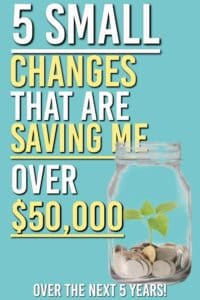Setting a financial goal can feel overwhelming and daunting.
A year ago, I set a financial goal to save $50,000 to invest in real estate. However, most months it was difficult to save even $100. How in the world would I reach $50,000?
With my goal in mind, I reviewed my budget. What I found was simple, yet somehow quite surprising.
I found many areas of my spending that I could adjust. These small adjustments were enough to save a surprising amount of money. Suddenly, my savings goal didn’t seem so overwhelming or far-fetched.
In this post, I’ll go over the 5 small changes I made that are saving me $57,000 over the next 5 years.
Eating out
As a full-time single mother working 40hrs a week, there are many nights that I just don’t feel like cooking. Or cleaning up after cooking, for that matter. It is so much easier to just go out to eat at a favorite restaurant or order takeout instead.
When I reviewed my monthly spending, I found that I was easily spending over $1200 on food every month. Over half of that was from eating out.
During the average busy week, my son and I were eating out about 4 times. That’s only including dinner. Not breakfast at the coffee shop on a rushed morning, or grabbing a pre-made sandwich or hot lunch for my son when I didn’t have time to pack his lunch.
Overall, I was spending an average of $500 a month of convenience food and restaurant dining.
Since I really don’t feel that it is realistic or reasonable to give up dining out all together, I have allowed for a small but strict dining budget.
My rule is that we can eat out wherever we want but when the money runs out, we are left eating at home the rest of the month.
I still love eating out, but my new budget is $200.
This saves at least $300 every month.
Or, a total yearly savings of $3,600.
Daily Latte Habit
Let’s face it, mornings or afternoons with a Starbucks latte treat are just so much better. When I’m in full swing latte habit, I have them just about every single day.
To make it worse, I often give in to a tasty snack to go with it. I have such a weakness for their marshmallow dream bar!
Cost of latte: $6
I do this at least 5 days a week: $6 x 5 days = $30 per week
Total yearly cost of my latte habit: $30 x 52 weeks = $1,560
Now obviously I’m not going to give up my coffee habit.
But, what if I were to make my own coffee every morning instead? Not only would it be beneficial to my wallet, but probably for my waistline as well!
Believe it or not, I ran all the numbers to calculate the cost of making my own coffee. I included all the equipment I would need to buy, the cost of high end coffee beans (because I may as well be picky if I have to make it myself) as well as the cream and flavored syrup I enjoy.
Total monthly cost: $18
Total yearly cost: $216
Now to calculate how much money I would save by kicking my Starbucks habit. This would be the total yearly cost of making my own coffee subtracted from the yearly cost of going to the coffeeshop.
Savings: $1,560 – $216 = $1,344
Of note, I also have the option of drinking pretty decent coffee at work for free!
This would make my savings the full $1,560.
The salon
Being an adult has its downsides. All the responsibilities, the stress, the long work hours. And, the grey hair!
Not everyone greys as prematurely as I do. Sadly, my hair became noticeably grey in my mid-20’s. And that’s just too young! I refuse to tolerate it.
And so, I was in the habit of visiting the salon every 5 weeks. I chose to go to a professional stylist because the color lasts longer, looks more natural and I believe better reflects my style and professionalism.
Additionally, the salon provides a social, relaxing and enjoyable environment to de-stress. I enjoy the time spent catching up with my stylist and I look and feel amazing when I walk out.
But, how much is this habit costing me every year?
How much could I save if I find a more frugal alternative to the salon?
To start out, I looked into how much I was actually spending every year.
As it turned out, I was spending at least $1,115.
While I wasn’t ready to ditch the salon and proudly sport the salt-and-pepper (or brassy box-dye) look just yet, I did come up with a compromise:
I found a professional box dye company online. The products were highly reviewed and great quality, similar to what is used in the salon.
I also found that I wasn’t using the whole product because I don’t have very long hair. I found a way to divide the supplies such that I actually get two uses out of each kit.
The cost of each kit is $25, ordered online every 8 weeks.
Total yearly cost of dying my own hair: $162
The next step is to calculate how much I will save by leaving my stylist and coloring my own hair.
Total yearly savings: $1,115 – $162 = $953
Transportation
When I review my budget by category, there are three areas that account for the majority of my spending. These are housing, food and transportation. So it made sense to review areas within these categories and find ways to cut back.
I really couldn’t find a way to cut back on my housing. I didn’t think I’d be able to cut back on transportation, either.
But then my work offered a really amazing incentive for utilizing alternative forms of transportation.
They were going to pay me to not park on campus.
I went back to my budget and reviewed my transportation options with a more open mind.
Here’s what I was spending every month to drive to and from work 5 days/week:
- Gas: $250
- Vehicle maintenance and repair: Average of $80
- Parking permit: $33
- Total: $366
- Time spent commuting: 2.5 hours per day
Here’s what I spent every month when I switched to a combination of biking and taking the train:
- Gas: $120
- Vehicle maintenance and repair: Average of $40
- Parking permit: $0
- Cost of riding the train: $0 (covered by my company)
- Credit for handing in my parking permit: $25
- Total: $135
- Time spent commuting: 2.5 hours per day, unless I count biking time as exercise, then my travel time is just 1 hour per day.
Additionally, I was able to save $50/year on my auto insurance because I wasn’t driving as often.
My total yearly savings by switching to biking and public transportation: $2,822
Groceries
The last budget category that I reviewed was my overall grocery spending.
I was spending at least $600 a month on groceries. As I tracked my finances and worked on my budget, I became more aware of my spending. I noticed that I wasn’t really using all of the food that I was buying.
I was eating out often and throwing away a lot of fruit, veggies and leftovers that I never got around to eating.
I also wasn’t very aware of what my favorite grocery store items cost.
In an effort to cut back on my spending, I downloaded my store’s app on my phone. This allowed me to save and track all my common purchases.
The app also shows me everything that is on sale. I started planning my shopping around what was on sale during a given week. If chicken was on sale then I would stock up on chicken rather than purchase full-priced beef.
As I got into the habit of this, I started reviewing the sales before I went shopping and planning out meals for the week based on the sales.
I found that I was much more aware of what I was purchasing and then actually using what I bought. My savings ranged from 15-30% on every visit and I stopped buying more food than I could actually use.
Now, my grocery budget is just $400/month.
Total yearly savings on groceries: $2,400
Putting it all together
If I review my total yearly savings for each category alone, I’m not super impressed. However, when I combined my total savings, I realized I was getting somewhere.
Here is a review of each savings category:
- Dining out: $3,600
- Daily latte: $1,344
- Salon color: $953
- Driving to work: $2,822
- Groceries: $2,400
My total yearly savings is therefore $11,119.
Or, roughly $915 extra savings every single month.
Now how overwhelming does saving for my financial goal of $50,000 seem? Not so bad! I could accomplish this in just under five years.
How to boost my savings even more
I have to say, when I first started making these small changes and running the numbers, I was pretty excited.
In fact, I started wondering if there was something more I could do to boost the money I was saving. I was a bit underwhelmed by the 0.01% interest my money was earning in my savings account.
So, I looked into opening an online high interest savings account.
After comparing a few options, I opened an online account that offers a 1.9% annual percentage yield (APY). While this doesn’t seem like enough to make a difference, it all adds up.
After setting up my new savings account, I set up automatic deposits of $915. At the end of the year I won’t just have the total savings of $10,980. My money will have earned interest every month.
Using a calculator tool from The Calculator Site, here is a table of what I will have saved over a total of 5 years:
At the end of the year, I will have earned $112.46 in interest. Taking advantage of time and compounding interest, I will have an additional $2,706 after 5 years.
That’s passive income that I didn’t have to earn or save. That’s free money!
How to boost my savings even more
I was so excited to see that I was actually able to save $50,000 in a relatively short period of time.
In fact, I was so excited that I didn’t want to stop there! I wanted to know if there were other options that would grow my savings even faster.
What I learned was that investing in low cost exchange-traded funds (ETFs) could be a great way to invest outside of my personal retirement account.
ETFs are a diversified basket of hundreds or thousands of individual stocks. Account management fees are very low and I’d be able to set up automatic monthly contributions.
My favorite all around option is the total index fund, which invests in the entire stock market in one manageable and super diversified package. It’s a conservative, long term plan that averages about 7% earnings per year.
This is a particularly appealing option because stock trading is not my specialty. I don’t know about the ins and outs of the market and I don’t want to. I do, however, want to benefit from the long term earnings that investing in the stock market provides.
Using the same calculator tool from The Calculator Site, here is a table of what my savings will look like with a 7% interest rate rather than continuing with my online savings account rate of 1.9%.
As you can see, at the end of 5 years, I will have almost $66,000 with a total interest gain of almost $11,000.
That’s a pretty significant incentive to cut back on my spending, switch accounts and invest my money!
Conclusion
Saving extra money can be a slow and defeating process. But with just a few spending changes, I was able to save so much more than I ever thought possible. Additionally, by utilizing compounding interest, I will be able to grow my savings to over $57,000 in just 5 years. Even more if I invest that money.
By making just a few adjustments to your own spending, you too can achieve your financial goals.
Dawn is a personal finance blogger at FI & Wine, which is all about enjoying life while on the journey to Financial Independence. She covers topics on saving money, investing, goal setting and finance for single parents.
*Do you have a story about how you have cut your savings? Share it with us. You can reach out to us via our contact page.
Find this useful? Share this others to spread how small changes add up!



